
What Is Marine Boiler?
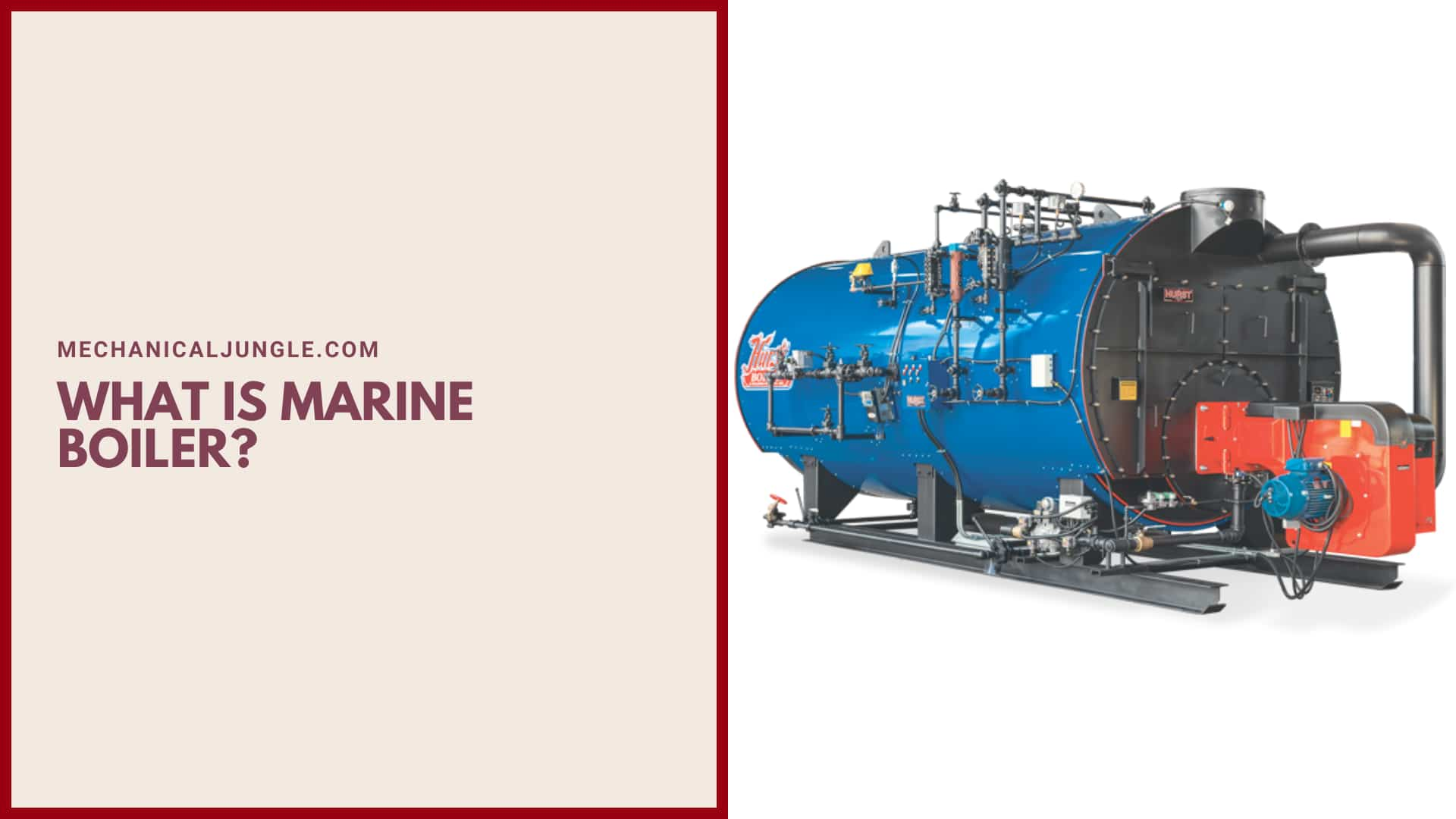
Marine boilers are of two types such as water tube boilers and fire tube boilers. Water-tube-type boilers are used for high-pressure, high-temperature, high-capacity applications.
The main boiler design depends on its application, ie. For motor ships, a small fire-tube boiler would be satisfactory. A boiler is machinery that has been in use since the early days of shipping when there were no auxiliary engines.
During that time, boilers were used to perform all the major functions that propulsion and power-generating systems currently do.
With the developments of technology, various types of machines performed important tasks on ships; However, an advanced boiler is still an important part of the engine power plant & cargo operations.
Considering their functionality, the materials used to manufacture the boilers should be such that they can withstand immense steam pressure and extreme temperatures with minimal damage to the surroundings.
Generally, carbon steel is used to construct pressure vessels, which are constructed by the open stove, electric, or pneumatic processes.
Important points to be considered for boiler manufacture is that the strength of the material used is tested according to regulatory requirements. (Note: Check this out if you need boiler and drainage cover)
Principle of Marine Boiler:
The marine boiler works on the simple principle of changing the state of water from liquid to vapor using heat energy. The water is boiled in enclosed pressure vessels so that the steam produced is not lost to the atmosphere.
The heating source is enclosed in insulated furnaces to ensure that heat energy is primarily transferred to the water and not to the surrounding area. Different types of boilers are used on ships depending on their size and type.
Types of Marine Boilers:

#1. Smoke Tube Boiler
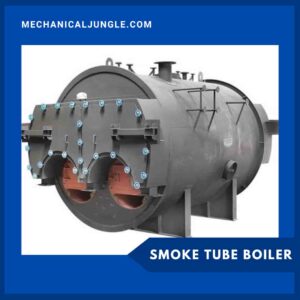
As the name suggests, the hot smoke generated in the boiler furnace passes through several tubes surrounded by water in the boiler drum.
The heat of smoke in the tubes generates steam. Smoking tube boilers are used in systems with low steam volume and quality. In a ship, smoke tube boilers can be described as – a horizontal or Scotch boiler and a vertical smoking tube boiler.
Vertical Smoke Tube Boiler:-
Vertical smoke tube boilers are more popular and are usually found on ships. In this boiler arrangement, the furnace is at the bottom of the boiler and connected to the shell through an ogee ring at the bottom.
The furnace is fitted with a refractory, which contains the heat produced inside the furnace & also protects the ogee ring from overheating. The combustion chambers with tube stacks are located above the furnace, where hot smoke is passed to heat the water drum.
The top of the combustion chambers is supported by a gusset plate that transfers tension to the boiler’s shell. Fire tube boilers are competitive for steams rates up to 12,000 kg/hr and pressure up to 18 kg / cm2. A Fire-tube boiler is available for operation with oil and gas fuel.
Horizontal Smoke Tube Boiler:-

This is an old type of boiler with a cylindrical furnace surrounded by water inside the shell. In such a boiler, the furnace is cooled with water, has a larger diameter, and is thicker.
This leads to thermal stress if the boiler is not operated correctly. Horizontal smoke tube boilers include endplates, as opposed to burner assemblies.
These flat-end plates supported by a large portion of steam remain in the upper part of the boiler. The combustion chamber is supported by staying on top of the girder and stopping the combustion chamber.
The mid-section backplate and tube plate are also supported by the stagnation of the combustion chamber.
#2. Water Tube Boiler
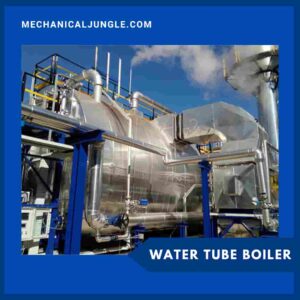
A water tube boilers can be defined as steam boilers that consist of the flow of water into the tubes, as well as hot gases. Not like fire tube boilers, these boilers achieve high pressure as well as high-steam capabilities.
Water-tube boilers are 2nd-generation boilers with modifications to the construction and working principle of smoking tube boilers.
The taps inside the boilers are filled with water instead of smoke, and therefore the thermal stress is lower than that produced by the faucet hose boilers. This type of boiler is used where the demand for steam quality and quantity is high.
All high-pressure boilers mainly consist of water tube boilers and mainly consist of 3 important sections:-
Water Drum:-
It is located at the bottoms of the boiler & carries hot water. The same waters are supplied to the steam drum where steam is produced.
Steam Drum:-
It is located in the top half of the boiler and is fitted with external and internal mounting, including safety valves and steam stop valves (main and auxiliary) to supply steam to the ship’s system.
Tubes:-
Modern water tube boilers have different types of water tubes with different functions. The main types are:-
Screen tubes:- Fitted before the superheater, these tubes are adjoining the furnace and absorb the flame as well as heat the generated gas. Since this tube is directly exposed to the heat of the furnace, they are of large diameter to prevent overheating.
Superheater tubes:- They are placed behind a screen tube to carry superheated steam from the boiler.
Generating tubes:- These tubes connect water drums and steam drums. As the name suggests, hot water is transported from the water drum to the steam drum, where steam is produced.
Downcomers:- Downcomers tubes transfer hot water that does not go into the water drum, where the water is heated in the generating tube before the steam goes back into the drum.
#3. Principle of Water Tube Boiler
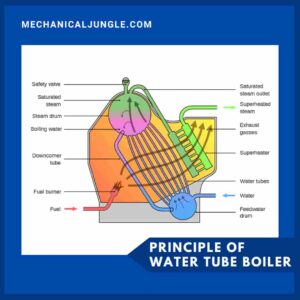
The water tube boilers work on the principle of convection & radiation. Most modern water tube boiler designs are at very high pressures within a capacity range of 4,500 – 120,000 kg / h. Many water tube boilers used as fuel for oil and/or gas are of “pack” construction.
The main features of water tube boiler are:-
- Forced, driven, and balanced draft provisions help improve combustion efficiency.
- Low tolerance for water quality for water treatment plants.
- High thermal efficiency level.
- high-pressure rating.
- Improved Steam Quality.
- Suitable for large capacity systems.
#4. Composite Boiler
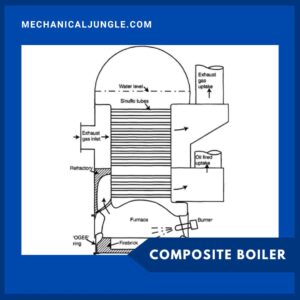
Another most common type of boiler found on ships is composite boilers, where the exhaust heat of the main engines or generator engine is used to heat water or generate steam.
Technically, the composite boiler is an integration of the exhaust gas boiler and the oil-fired boiler. A composite boiler can be a water hose or a smoking tube boiler divided into two separate sections.
One part of the boilers is heated by the burner and the other by the exhaust gases produced by the ship’s engine.
#5. Exhaust Gas Boiler
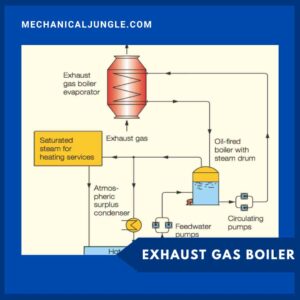
Exhaust gas boilers and economizers are types of heat recovery units and water tube boilers. Flue gases from the exhaust of the engines are used to heat water in tubes at a specific temperature and confined pressure.
Circulation pumps are used to continuously circulate hot water into the water tubes of the economizer. The auxiliary steam boiler acts as a steam separator for the entire system and thus is kept warm and ready to start immediately.
When the main engine is running at a high load, the excess steam produced by the economizer is thrown back into the hot well using a steam dump condenser.
The exhaust boiler is provided with a vertical register of double steel tubes with steel gills welded on the tube. It provides a strong, rigid structure and also helps prevent damage caused by vibration.
Since hot gases flow from the boiler trunk to heat the water, the full exhaust boiler suffers from thermal expansion, which is controlled by fitting different tubes and plates. The tube register, tube support, and tube bends are placed in the direction of the flow of exhaust gases.
The tube support is fixed on one side of the inlet and one auxiliary beam on one side of the outlet header. The other end is kept free from the supporting beam for thermal expansion.
Boiler foundations are provided with footplates, which also support the structure and absorb thermal expansion. For additional robustness and support, the style is fitted with a raised eyeball to the steel structure at the top side.
Difference Between Smoke and Water Tube Boilers:
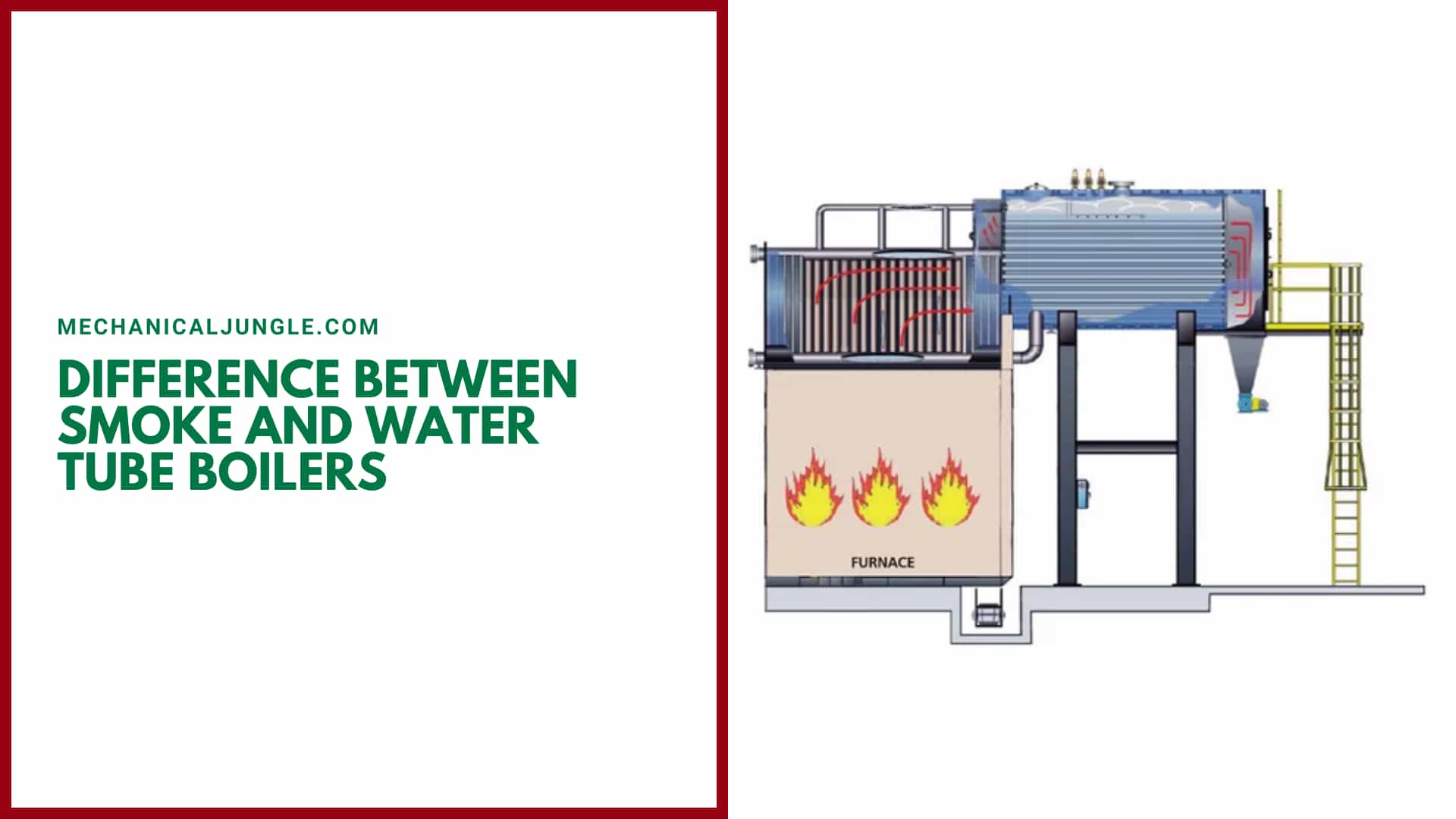
| Smoke Tube Boiler |
Water Tube Boiler |
| Suitable for low-pressure range | Suitable for high-pressure range – 100 bars |
| High thermal stresses | Low thermal stresses |
| Low quality & quantity of steam | High quality & quantity of steam |
| Less efficient | Highly efficient |
| Large diameter tube | Small diameter tube |
| Heavy in weight | Light in weight for the same capacity |
| The risk of the explosion is less | The risk of explosion is high |
Frequently Asked Questions (FAQ) About Marine Boilers
What Are the Main Types of Marine Boilers?
The main types of marine boilers are water tube boilers and fire tube boilers. Additionally, composite boilers and exhaust gas boilers are also commonly used on ships.
What Is the Principle Behind the Operation of a Marine Boiler?
Marine boilers operate on the principle of converting water from liquid to vapor using heat energy. The water is boiled in enclosed pressure vessels, ensuring that the produced steam is not lost to the atmosphere.
What Materials Are Used to Construct Marine Boilers?
Generally, carbon steel is used to construct pressure vessels in marine boilers due to its ability to withstand immense steam pressure and extreme temperatures. These materials are tested according to regulatory requirements to ensure their strength and durability.
What Is the Difference Between Smoke Tube Boilers and Water Tube Boilers?
Smoke tube boilers have hot smoke passing through tubes surrounded by water, while water tube boilers have water passing through tubes surrounded by hot gases. Water tube boilers are more efficient, suitable for high-pressure ranges, and produce high-quality steam compared to smoke tube boilers.
How Does a Vertical Smoke Tube Boiler Differ from a Horizontal Smoke Tube Boiler?
In a vertical smoke tube boiler, the furnace is at the bottom, connected to the shell through an ogee ring, with the combustion chamber above the furnace. In a horizontal smoke tube boiler, the furnace is cylindrical, surrounded by water inside the shell, and is cooled with water to prevent thermal stress.
What Are the Main Components of a Water Tube Boiler?
The main components of a water tube boiler include the water drum, steam drum, and various types of tubes (screen tubes, superheater tubes, generating tubes, and downcomers). These components work together to produce and manage steam efficiently.
What Is a Composite Boiler, and How Does It Function?
A composite boiler is an integration of an exhaust gas boiler and an oil-fired boiler. It uses the exhaust heat from the ship’s main engines or generator engines to heat water or generate steam, providing an efficient use of available heat energy.
What Is an Exhaust Gas Boiler, and What Is Its Role on a Ship?
An exhaust gas boiler is a type of heat recovery unit that uses flue gases from the ship’s engines to heat water in tubes. It acts as a steam separator for the entire system and is designed to handle thermal expansion while providing a robust and efficient heat recovery solution.
Why Is It Important to Control Thermal Expansion in Exhaust Gas Boilers?
Controlling thermal expansion in exhaust gas boilers is crucial to prevent damage caused by the differential expansion of tubes and plates. This is achieved by fitting different tubes and plates and providing supports that can accommodate thermal expansion.
What Are the Safety Considerations for Marine Boilers?
Safety considerations for marine boilers include ensuring the strength of construction materials, proper maintenance, and regular testing according to regulatory standards. High-pressure boilers, in particular, require careful monitoring to prevent explosions and ensure safe operation.

